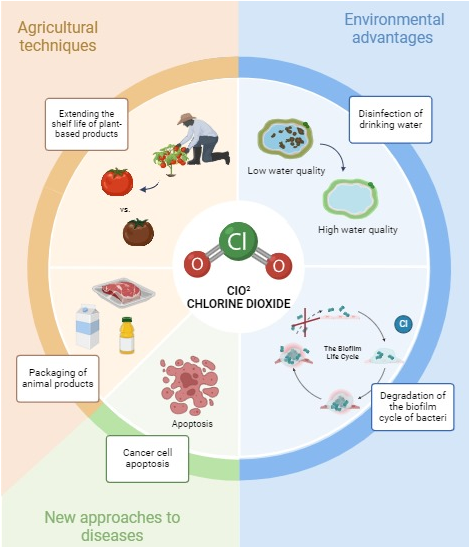JOURNAL 3106
Records of Agricultural and Food Chemistry
Year: 2024 Issue: 3 Special Issue: Abstracts 3rd. TCS, International Food Chemistry Congress February 29-March 03,2024 Antalya Türkiye
p.38 - 38
Viewed 1243 times.
GRAPHICAL ABSTRACT

ABSTRACT
Research is being carried out on environmentally friendly agents to protect human and animal health. Different forms of chlorinated disinfectants are frequently used in food businesses. Chlorine dioxide is an extremely effective biocide and is used in the food industry and in the disinfection of drinking water. Chlorine dioxide, a strong oxidant, has its own electron exchange mechanism. Oxidizing agents are chemical compounds that can easily accept electrons from electron donors. Being a reactive radical for the surfaces it comes into contact with, it has an anti-infective effect due to its oxidation effect. Chlorine dioxide disperses the cell walls and membranes of microorganisms, killing them or eliminating their infectivity. However, healthy tissues and microorganisms that feed on oxygen are not affected by chlorine dioxide [1,2]. The fact that chlorine dioxide has a very unstable structure is the secret of its success in killing pathogens. This feature also prevents the development of resistance [2]. It is used safely in the livestock industry, in slaughterhouses, production and packaging areas of animal products. Washing fruits and vegetables with chlorine dioxide solution extends their shelf life and disinfection with chlorine dioxide is performed in food packaging [3]. Recent studies have shown that chlorine dioxide is a more effective disinfectant against Cryptosporidium oocysts than free chlorine [2]. It has been observed that it is effective on cancer cells by inducing apoptotic cells [1,4]. It was stated that the patient with pancreatic metastatic adenocarcinoma returned to normal and the course of the disease improved without metastasis and remained stable for 18 months [5]. Another patient with hormone-refractory metastatic prostate cancer was reported to experience a sharp decline in PSA level while improving general health [5].
KEYWORDS- Human
- animal
- environmental health
- infection
- chlorine- dioxide
- usage